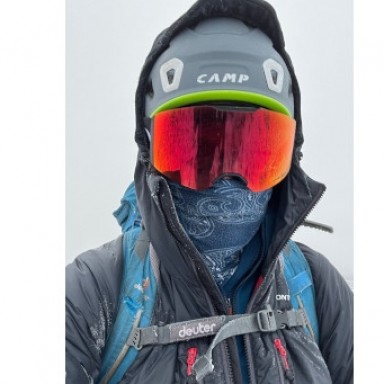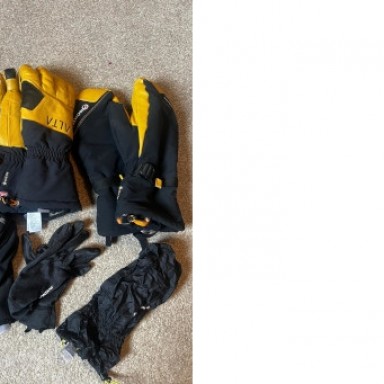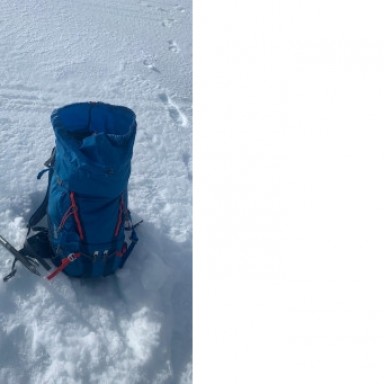
Winter Walking and Mountaineering: An Essential Kit List
Posted On: 28th December, 2024
Winter in the mountains is pure magic—sparkling snow, crisp air, and those jaw-dropping views that make every step worth it. But let’s face it: winter is also a season where conditions can be arduous at best and preparation can make or break your day. If you’ve ever thought winter mountaineering is just for hardcore experts with endless budgets—or that you need to lug half your body weight in gear—think again! With a few smart tweaks, some careful planning, and a touch of insider know-how, winter adventures can be safe, fun, and surprisingly straightforward.
This guide is here to make it all simple. It’s a checklist packed with tips from seasoned guides who’ve seen it all—from dazzling blue-sky days to ‘why did I leave the house?’ blizzards. Whether you’re gearing up for your first winter trip, prepping for a winter mountaineering course, or planning your fiftieth snowy adventure, we’ll show you what to pack (and why) to give you the confidence to head out. Got questions, tips of your own, or just want to chat gear? Hit us up on social media—we love talking all things winter!
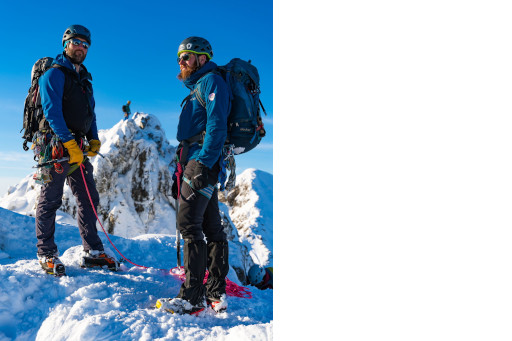
Photo credit: Peak Climbing School
Tick List: What to Pack for Winter
- Rucksack (45L+)
- Dry bags and waterproof liners
- Waterproof jacket and trousers
- Base layers
- Walking trousers
- Fleece
- Insulated jacket (synthetic or down)
- Walking socks
- Winter boots (B1, B2, or B3)
- Crampons
- Hat and multiple pairs of gloves
- Ski goggles
- Sunglasses and sun cream
- Head torch with spare batteries
- Compass
- Map and map case
- Digital watch
- Snow shovel
- Avalanche probe
- Ice Axe
- Walking poles with snow baskets
- Personal first aid kit
- Loo paper and dog poo bags
If it's helpful there's a downloadable photo at the end
Rucksack (45L+)
Winter mountaineering requires more clothing and specialised equipment, so a larger rucksack is essential. Choose one big enough to store everything inside, as exposed gear can get wet and freeze. Always use internal dry bags to prevent kit getting wet but you can also consider a waterproof pack to limit the water the rucksack itself absorbs, increasing its weight. Buckles often outperform zippers in icy conditions, so prioritise durability. Don't stress too much about ice axe attachement options, side compression straps are a good feature for keeping the bag compact and stable when it's not full and is an ideal place for stowing your walking axe, without the need for taking your bag off.
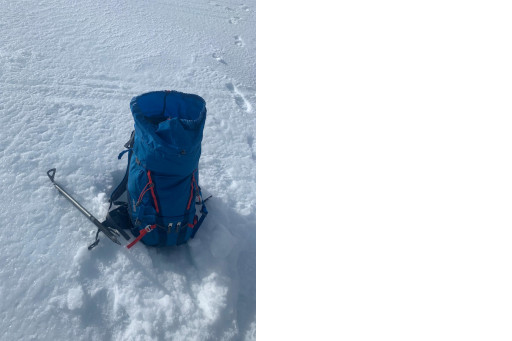
Photo credit: Peak Climbing School
Dry Bags and Waterproof Liners
Use a large dry bag or a rubble sack to shield your gear from the most of the water. A top tip is to organise essentials like gloves and electronics into smaller, coloured dry bags for quick location. It also means that nothing else gets wet, whilst you're rooting around.
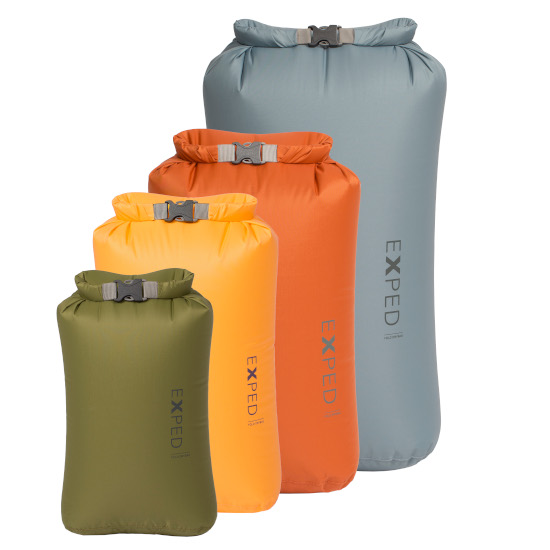
Photo credit: Exped
Waterproof Jacket
A high-quality waterproof jacket is a must. Look for features such as:
- Taped seams: to prevent water ingress.
- Waterproof materials: preferably in a 3-layer design for durability. Gore-tex and eVent are common brand names but most of the big brands have some good performing materials.
- No insulation: it is best not to have any inbuilt insulation. It's common to get hot walking uphill, so an ability to be flexibile with layering helps.
- A helmet-compatible hood: for steep adventures.
- Longer length: to overlap waterproof trousers. Some brands describe this as an active fit, or a drop tail.
- Large functional pockets: for maps, compasses and snacks.
Waterproof Trousers
Look for waterproof trousers with full-length side zips, to slip them on without removing boots. Trousers with just poppers often aren't enough for winter wetness.
For something winter specific, non-insulated hard-shell salopettes are ideal for winter, due to their high-waist design and gaiter integration, offering superior overlap with jackets.
If your trousers don't have gaiters, it's worth investing in seperate ones.
Top tip: Store trousers in your pack with zips open for quick deployment.
Base Layers
Avoid cotton, as it retains moisture. Instead opt for merino wool or synthetic materials to wick moisture away from your skin. Synthetic base layers are often cheaper and perform well enough but they do tend to smell fairly quickly. Merino is excellent at regulating temperature, soft and doesn't smell as quickly, you'll often get away with multiple days' wear. Avoid cheap merino, it's generally a blend of materials and can be itchy and uncomfortable.
String vests and long johns are less common, but are trusted by the Scandinavian special forces and mountain guides, as they offer great ventilation and are oddly warmer than alternatives.
Walking Trousers
Standard synthetic walking trousers work well, but in very cold conditions, pair them with thermal leggings. You can also buy thicker winter-specific trousers for added insulation if you prefer.
Fleece
A fleece top provides versatile insulation, even when damp. They often offer high warmth to weight and pack size. Hooded fleeces offer added protection for your head and ears, though multiple hooded layers can feel bulky. Opt for quick-drying synthetics or wool.
Insulated Jacket
For wet, cold conditions, synthetic-filled jackets are often the smarter choice over down. While down offers excellent warmth-to-weight ratio in dry conditions, it loses its insulating properties when wet. Synthetic materials, on the other hand, retain their ability to keep you warm even when damp, making them more dependable in the UK’s famously damp and variable climate. Although synthetic jackets may be bulkier, their reliability in these conditions justifies the trade-off.
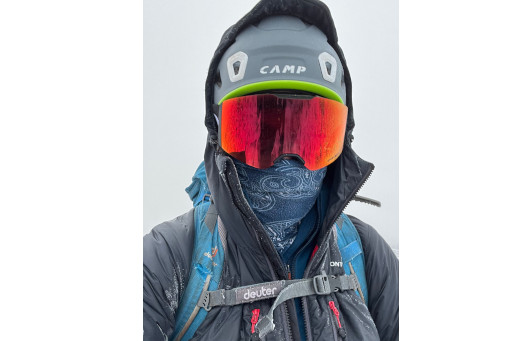
Photo credit: Peak Climbing School
Walking Socks
Choose socks based on boot insulation and activity. Thin socks with cushioning—typically made from synthetic or merino wool blends—work well with insulated boots or an uninsulated boots, when spending a lot of time travelling which generates heat. Thicker socks are better suited for prolonged stationary activities in very cold conditions or if you suffer with cold feet. Overly thick socks can compress your feet, reducing circulation and causing friction, and can result in overheating and blisters. So don't feel a need to for old-school very thick socks.
Winter Boots
It can be easy to overcomplicate selecting boots, mostly it's good to have something with a stiffer sole (to enable you to kick steps into firm snow) and deeper tread (to provide plenty of traction). Winter boots come in a variety of different stiffnesses, so be sure to select boots with a stiffness rating to match your crampons:
- B1: Slightly stiffer than summer boots, generally for light winter walking.
- B2: Ideal for winter walking in Scotland, suitable for moderate climbing but still light and flexible.
- B3: Rigid boots for technical climbing and maximum insulation. These are generally heavier and can be uncomfortable to walk around in.
If you're not looking to buy a pair of boots, most popular winter walking areas have a local shop that you can hire boots from.
Crampons
Crampons, like boots, have a stiffness rating. You can fit a softer crampon to a stiffer boot, but not a softer boot to a stiffer crampon. For example, you can fit a C1 or C2 crampon to a B2 boot, but you can't fit a C3 crampon to a B2 boot. There is some variance in crampon models, so it can be worth checking compatability with your boot model.
- C1: The softest of the crampons and the most comfortable to walk in, most of the points are vertical to allow the crampon to have some float in the snow. They generally feature a basket at the front and rear of the crampon, so have a fairly universal fitting.
- C2: A stiffer crampon, great for bridging the gap from walking to gentle climbing. They have a mix of vertical walking points and horizontal climbing points. They often have a basket at the front and a clip at the rear, this clip only fits on boots with a rear welt (ledge). These are often referred to as semi-automatic crampons.
- C3: The stiffest of the crampons and largely designed for climbing. These crampons have either twin or mono points at the front specifically for climbing vertical terrain. Depending on your objectives for the day will determine whether you choose a twin or mono point (Some models are even changable between the two). C3 crampons are generally a more specialist tool so some deeper research or expert advice may be required to ensure you're getting the right crampons for you. A fully automatic crampons will require a welt at both the front and rear of your boots.
When walking in soft snow it is easy for the snow to build up underneath your crampons making it harder to walk and also potentially preventing your crampon points from digging into the snow surface. The result of this may be a slip or fall with potentially serious consequences. We'd always recommend you use crampons with inbuilt anti-balling plates.
Top Tip: Practice putting your crampons on at home wearing your winter gloves, so you become efficient even with limited finger dexerity before head out in winter conditions.
If you are joining us for a winter skills course a pair of C1 crampons will be provided.
Hat and Gloves
In the wet and wild conditions of a Scottish winter, gloves don’t just get damp—they get saturated. Expect to go through several pairs in a day, so carrying multiple pairs is crucial. Thin gloves are perfect for walking or tasks requiring lots of dexterity, while mid-weight gloves are great for active use in colder temperatures. When stationary or completing tasks that involve touching snow or being in contact with metal objects (like using ice axes) or if conditions turn particularly cold, then more insulated gloves become essential. Mitts allow your fingers to share heat, so they provide maximum warmth, but provide limited dexterity. Opt for gloves with water-resistant materials and adjustable cuffs to keep out snow and moisture. You can get waterproof over mitts for added prottection.
Whether prepping for your first winter outing or gearing up for a winter mountaineering course, keeping your hands warm and dry is vital.
To complete your setup, pack a woolly hat or a thin, helmet-compatible beanie to trap body heat—especially important when battling icy winds. Should conditions turn really nasty a balacava enables your whole face to be protected and can reduce the risk of frost nip or bite.
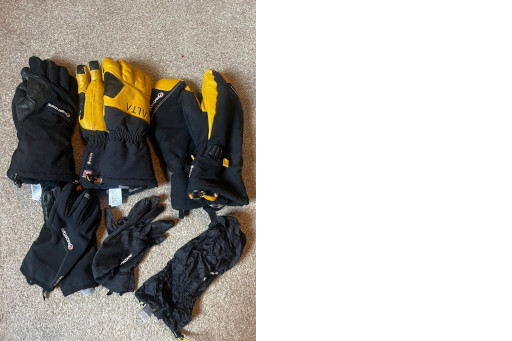
Photo credit: Peak Climbing School
Ski Goggles
Protect your eyes from driving snow, wind, and glare with clear or lightly tinted ski goggles designed for low light conditions. In the wet and freezing conditions of a Scottish winter, keeping your goggles dry is essential to prevent freezing and misting. Store them in a dry bag when not in use and consider using anti-fog treatments to maintain visibility.
Sunglasses and Sun Cream
Bright snowy days demand UV protection. Sunglasses with Category 2 lenses as a minimum are ideal for winter conditions. High-factor sun cream protects against sunburn, especially with sunlight reflecting off snow.
Head Torch and Spare Batteries
Choose a head torch with a strong brightness and long battery life, one like the Alpkit Quark or Petzl Tikka are good benchmarks. Keep spare batteries warm in a body pocket to ensure they work when needed. Consider carrying a spare headtorch if it has an intergrated battery.
Phone Charger
Batteries drain faster in the cold. A powerpack and appropriate cables are essential.
Compass
In the ever-changing weather of the mountains, a reliable compass, such as the SILVA Exped, is indispensable for safe navigation. Over time, most compasses develop a bubble, which can make accurate navigation difficult, but SILVA's robust warranty ensures peace of mind. The Exped’s large, rubbersed bezel is easy to handle even with bulky gloves, making it ideal for winter use. Attaching your compass to your gear with a lanyard or cord is crucial in bad weather to prevent it from being dropped or blown away, and carrying a spare compass is always a smart move in challenging conditions.
Maps
When it comes to maps, there are pros and cons to consider between OS and Harvey maps—the two most common options. OS maps, available in 1:25,000 and 1:50,000 scales, offer detailed terrain data, while Harvey maps, with their 1:40,000 scale, focus on key mountain features and often prove more practical when snow obscures finer details. Laminated OS Active maps are durable, but some mountaineers prefer traditional paper maps paired with a map case for flexibility in windy, wet conditions. Together, a dependable compass and map are the backbone of confident and effective navigation in the winter wilderness.
Digital Watch
A simple referee’s watch with a large face and backlight helps to time distance in poor visibility. Use an elastic strap to wear it over clothing layers for easy access.
Snow Shovel and Avalanche Probe
Both tools are vital for safety in avalanche-prone terrain, as well as building emergency shelters. Opt for a metal-bladed collapsible shovel and a 2.4m avalanche probe. Knowledge of how to use them is just as crucial as carrying them.
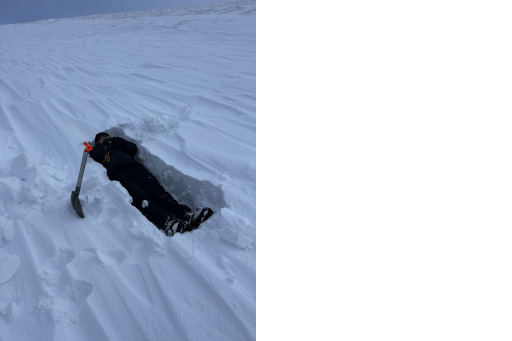
Photo credit: Peak Climbing School
If you are joining us for a winter skills course a shovel and probe will be provided.
Ice axe
For a simple walking axe looking for something with an adze on the back is ideal. It should be fairly straight shafted and described as a walking axe. When you hold the axe by the head the lower point should be about the same height as the top of your boot. For travelling on steeper ground you some consider going for a shorter axe, as a longer length makes walking on steeper slopes and chopping steps more difficult. It's worth visiting a shop with some knowledgable staff to make sure you get the right tool!
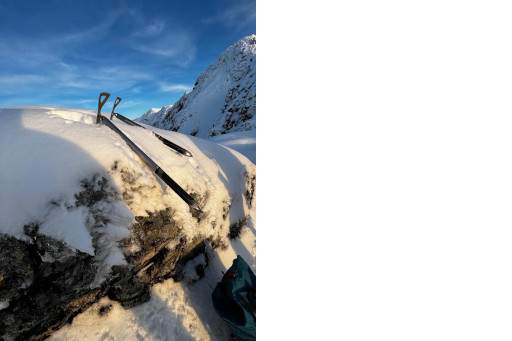
Photo credit: Peak Climbing School
If you are joining us for a winter skills course a walking axe will be provided.
Walking Poles with Snow Baskets
Walking poles make a world of difference when moving on broken ground and travelling steeply up or down hill. They give you added stability and reduce effort for walking. By adding a snow basket on the base of your walking poles it prevents them sinking into the snow when pressure is applied to them!
Personal First Aid Kit
Tailor your kit to your needs, including painkillers, blister plasters and any necessary medication. Carry only what you know how to use.
Loo Paper and Dog Poo Bags
Leave no trace, even in winter. Use dog poo bags to carry out your waste and toilet roll. This prevents contamination of the mountain landscape and waterways during the springtime snowmelt.
The 'Keep Cairngorm Snow White' Project is operated by the Cairngorm Mountain Ranger Service and provide dedicated poo tubes for free to utilise if you get caught out on Cairn Gorm. The project aim's is to reduce the amount of human waste being left in the mountains. The tubes can be collected and returned to the Cairngorm Mountain Rangers station at the Cairngorm mountain ski centre.
As you gear up for your next winter adventure, remember that preparation is the key to staying safe and having fun in the mountains. We hope this guide has given you the knowledge and confidence to pack wisely and step out into the snow with purpose. You can use our list as a starting place but keep tweeking things to fit your needs and as you figure out what you like. As always if you have any questions, need help choosing the right gear, or just want to share your winter adventures get in touch. Stay safe, stay warm, and we'll see you out there!
Save this photo for a reference on your phone
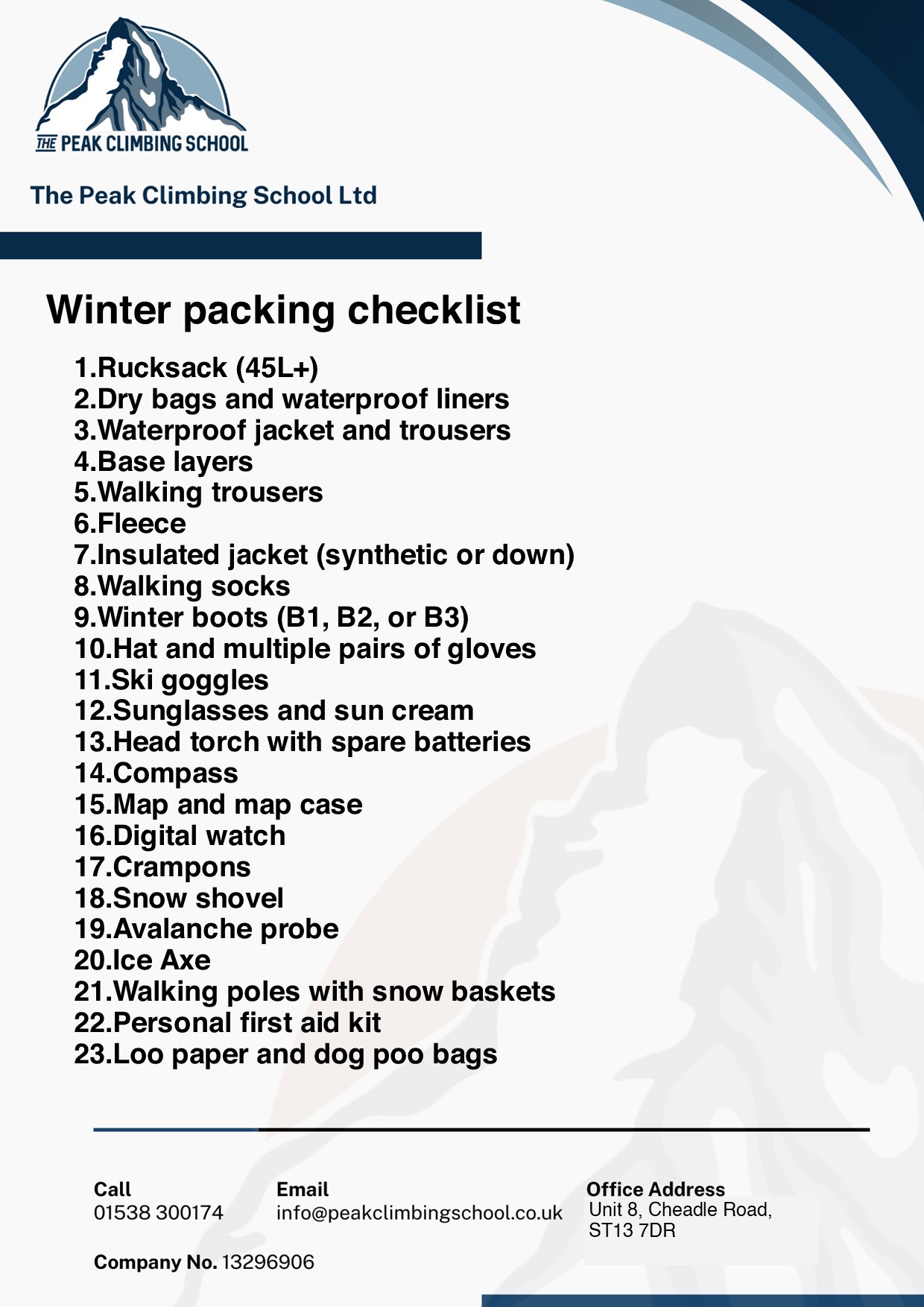
Share this Article
Recent Blog Posts


D of E Kit List: The Ultimate Packing Guide
Posted: 16th February, 2025 Read Article
Sintra- Bouldering Destination Guide
Posted: 21st January, 2025 Read Article
What to Pack for a Climbing Course: An Essential Kit List
Posted: 14th January, 2025 Read Article

